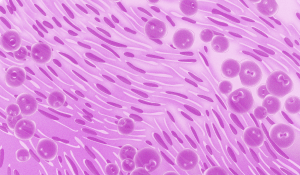What Is Biphasic Mesothelioma?
Biphasic mesothelioma is the second most common cell type of malignant mesothelioma. Between 20% and 30% of all mesothelioma cases are this cell type, according to the American Cancer Society (ACS).

Biphasic tumors are made up of both epithelioid and sarcomatoid cells, which are the other two main mesothelioma cell types.
- Epithelioid cells are rectangular. These cells tend to stick together and spread less quickly through the body.
- Sarcomatoid cells look like long narrow spindles. Because of their shape, they do not stay together as well and can spread very quickly, making this the most dangerous cell type.
There may be more epithelioid or more sarcomatoid cells present in a biphasic mesothelioma tumor. Patients tend to have a better prognosis (health outlook) if there are more epithelioid cells.
If you’ve been diagnosed with biphasic mesothelioma or any other type of this cancer, we can help. Get your Free Mesothelioma Guide shipped overnight to learn more.
Biphasic Mesothelioma Symptoms
Biphasic mesothelioma has several symptoms that may present before a patient goes to the doctor.
Patients with biphasic mesothelioma may experience:
- Blood in stool (fecal matter)
- Chest pain
- Coughing up blood
- Dry cough
- Shortness of breath
- Shoulder and rib pain
- Swelling
- Unexplained weight loss
- Upper back pain
- Vomiting up blood
Mesothelioma symptoms do not differ dramatically between each cell type. They do differ based on where biphasic mesothelioma forms in the body, however.
For example, there is often fluid buildup in the lung lining in cases of biphasic pleural mesothelioma. This fluid buildup can cause shortness of breath. In cases of biphasic peritoneal mesothelioma, the fluid builds up in the abdominal lining and leads to swelling.
Biphasic Mesothelioma Diagnosis
Biphasic malignant mesothelioma is diagnosed through a variety of methods. After a physical exam, doctors use imaging tests such as X-rays and computed tomography (CT) scans to look for signs of mesothelioma and locate the tumor.
Afterward, a biopsy is performed. This test allows doctors to extract a tissue or fluid sample from an area that could be cancerous.
While imaging scans can help a doctor make a biphasic mesothelioma diagnosis, a biopsy must be done to confirm it.
Pathologists (doctors who specialize in examining diseased tissue and making diagnoses) examine the cells of the tissue sample.
They may also use techniques such as immunohistochemistry to find characteristics unique to certain cell types. For a biphasic mesothelioma diagnosis, both sarcomatoid and epithelial cells must be present.
Our team can connect you with top specialists diagnose and treat biphasic mesothelioma. Get started with our Free Doctor Match.
Rare Types of Biphasic Mesothelioma Cells
Biphasic mesothelioma tumors are sometimes made up of rare subtypes of epithelioid or sarcomatoid cells. These types occur in less than 1% of all mesothelioma cases.
Rare subtypes of biphasic mesothelioma include:
- Adenoid cystic mesothelioma: This is an extremely rare type of epithelial mesothelioma. Only a few hundred cases have been reported worldwide.
- Adenomatoid mesothelioma: This rare form of epithelial mesothelioma can sometimes be mistaken for a benign tumor, according to a 2022 study from the Journal of Medical Case Reports.
- Deciduoid mesothelioma: This is an uncommon type of epithelial mesothelioma that forms in the lining of the abdomen. It is most commonly found in young women shortly after pregnancy.
- Papillary mesothelioma: This is often called well-differentiated papillary mesothelioma. It is very uncommon and forms in the peritoneum (lining of the abdomen).
- Small cell mesothelioma: This is an extremely uncommon type of mesothelioma. It is sometimes mistaken for small cell lung cancer but has a slightly different cellular makeup, according to the medical journal Translational Lung Cancer Research.
Biphasic Mesothelioma Prognosis
The general prognosis of biphasic mesothelioma depends largely on the ratio between epithelial and sarcomatoid cells. If the tumor has more epithelial cells, the patient’s mesothelioma prognosis is better since those cells are easier to treat.
Prognosis is typically measured using two main factors: Life expectancy (the average time a patient lives after a diagnosis) and survival rate (the percentage of patients still alive after a set period of time).
- The average life expectancy for biphasic mesothelioma patients is 10 months, according to an F1000 Research report.
- The average 5-year survival rate for biphasic mesothelioma is 20%. This means that around 20% of patients with biphasic mesothelioma live at least 5 years after diagnosis.
That said, some biphasic patients may be able to live longer if they undergo aggressive mesothelioma treatments.
Biphasic Mesothelioma Treatment

There are several different mesothelioma treatment options for patients who are diagnosed with biphasic mesothelioma. Which treatments will work best depends on the patient’s age, mesothelioma stage, and percentage of sarcomatoid versus epithelial cells.
Chemotherapy
Chemotherapy is often the first treatment used for biphasic mesothelioma. It may work well for patients with a large number of epithelioid mesothelioma cells, especially when combined with surgery.
Sarcomatoid-dominant biphasic mesothelioma is more resistant to treatment, but chemotherapy may still help because it circulates through the entire body, destroying sarcomatoid cells that have spread.
Chemotherapy may be more or less effective depending on the age, health, and cancer stage of the patient, as well as how well the patient tolerates chemotherapy.
Radiation Therapy
Radiation therapy is mainly used to reduce the pain and suffering of a patient with biphasic mesothelioma.
It may also be used as part of a multimodal treatment plan, in which several treatments are used together to fight cancer. Chemotherapy, radiation, and surgery can all be used as part of a multimodal plan to treat biphasic mesothelioma.
Surgery
Mesothelioma surgery is often an aggressive treatment option. It can be very effective if the biphasic mesothelioma is primarily made up of epithelioid cells.
Since these cells stick together and do not usually spread as quickly throughout the body, surgeons can often remove all visible cancer tumors, improving survival.
If the patient’s biphasic mesothelioma consists of more sarcomatoid cells, a doctor may not suggest mesothelioma surgery — particularly if the cancer has already spread through the body.
Not sure which biphasic mesothelioma treatments will be best for you? Download our Free Questions to Ask Your Doctor Checklist to get the answers you need.
Other Biphasic Mesothelioma Treatments & Tests
Besides the treatments mentioned above, doctors can use many other medical options to help those with biphasic mesothelioma live as long as possible.
- Clinical trials are currently studying new ways to treat biphasic mesothelioma. For example, photodynamic therapy is an emerging science that uses light to kill cancer and is one of just many treatments currently being tested in trials to help biphasic mesothelioma patients. Patients often have to meet certain criteria to participate in a clinical trial.
- Genetic testing is also being used to determine who might be more predisposed to getting mesothelioma, helping people in these groups get diagnosed earlier and improving their prognosis.
- Immunotherapy is a treatment that doctors are using more and more frequently for mesothelioma patients. This treatment improves the immune system’s ability to fight cancer. This treatment is currently approved to treat biphasic pleural mesothelioma.
When considering a treatment plan for biphasic mesothelioma, make sure to ask your doctor about other options such as immunotherapy or a clinical trial. Your doctor can take these into consideration and determine which options (if any) will be most helpful for you.
Hope for Victims of Biphasic Mesothelioma
Being diagnosed with malignant biphasic mesothelioma can be scary. Further, facing cancer treatments — and the expenses that come with them — can be stressful.
The good news is that long-term survival is possible in some cases with the right medical care, and you may qualify for financial aid to help medical treatments with financial aid.
The Mesothelioma Hope team is here to support you as you navigate your biphasic mesothelioma diagnosis. Whether you or your loved one needs help finding a doctor, information on treatment options, or exploring treatment payment options, we can help.
Get our Free Mesothelioma Guide for more information.
Biphasic Mesothelioma FAQs
How common is biphasic mesothelioma?
Biphasic mesothelioma is the second most common mesothelioma cell type. Roughly 2-3 of every 10 mesothelioma patients will have biphasic mesothelioma, according to data from the ACS.
Can biphasic mesothelioma be treated?
Yes. While biphasic mesothelioma typically doesn’t respond as well to treatment as epithelioid mesothelioma does, there are often many therapies available to help patients.
Commonly used biphasic mesothelioma treatments include surgery, chemotherapy, radiation, and immunotherapy. New and possibly more effective treatments may be available in clinical trials too.
Ask your mesothelioma doctor about which biphasic mesothelioma treatments will work best in your case.
What is the cause of biphasic pleural mesothelioma?
The only known cause of biphasic pleural mesothelioma — and all other mesothelioma cell types — is asbestos exposure.
Tiny asbestos fibers, if inhaled or swallowed, can get trapped in the body and damage cells, eventually causing them to mutate and become cancerous.
Doctors don’t yet fully understand why some people will develop biphasic mesothelioma and others get epithelioid or sarcomatoid mesothelioma.




